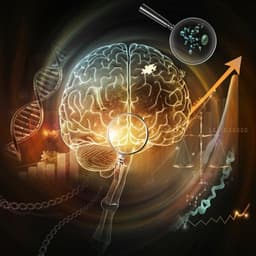
Psychology
Using machine learning to understand social isolation and loneliness in schizophrenia, bipolar disorder, and the community
S. J. Abplanalp, M. F. Green, et al.
Discover how social disconnection affects mental health in conditions like schizophrenia and bipolar disorder, as revealed by cutting-edge machine learning research conducted by Samuel J. Abplanalp and colleagues. This study uncovers critical predictors of social isolation and loneliness, highlighting the role of social anhedonia and nonsocial cognition across different populations.
~3 min • Beginner • English
Introduction
The study addresses the substantial health risks of social disconnection—comprising social isolation and loneliness—particularly in schizophrenia, where prevalence may be as high as 80%. Prior work links isolation and loneliness to immune dysregulation and early mortality, yet predictors in serious mental illness, and specifically schizophrenia, are under-characterized. Drawing from literature in serious mental illness and the general population, candidate predictors include nonsocial cognition, social cognition, social anhedonia, social avoidance motivation, and depression. The research question is which factors uniquely predict social isolation and loneliness within schizophrenia and how these relationships compare with bipolar disorder (BD) and a community sample (CS) enriched for isolation. Using an enriched community recruitment strategy to match distributions of social isolation across groups, the study aims to avoid confounds from group-level differences. Employing LASSO regression enables simultaneous modeling of main effects and group interactions while mitigating overfitting, to identify parsimonious predictors of social disconnection within and across diagnostic groups.
Literature Review
Evidence in serious mental illness suggests links between social isolation and nonsocial cognition, social cognition, and social anhedonia. In the general population, nonsocial cognition, social cognition, social avoidance, depression, and isolation predict loneliness. Data-driven analyses in schizophrenia indicate anhedonia as a central node connecting domains of social functioning, but its unique contribution to isolation and loneliness remains unclear. Schizophrenia typically shows greater impairments in social cognition and motivation than BD, though BD remains more impaired than healthy controls. Prior work also shows modest associations between isolation and loneliness in general samples, with possible stronger coupling in some psychiatric or enriched samples. This literature motivated testing five predictors (social anhedonia, social avoidance, depression, nonsocial cognition, social cognition) for their unique associations with isolation and loneliness across groups.
Methodology
Design and samples: Cross-sectional study of 72 outpatients with schizophrenia, 48 with bipolar disorder (BD), and 151 community participants (CS), with the CS enriched for social isolation via targeted online ads; remaining CS participants recruited via unselected ads. Diagnoses (for clinical samples) via SCID-5; CS screened with SCID-5 and sections of SCID-PD; CS excluded for lifetime psychotic or bipolar disorders. Inclusion: age 20–60, English proficiency. Exclusion: neurological disease, serious head injury (LOC >1 h), sedatives/benzodiazepines within 12 h, IQ <70 or developmental disability (WRAT-3 reading), moderate+ substance use disorder within 3 months, current mood episode (depression, hypomania, mania). Clinical samples were clinically stable (no hospitalizations within 3 months, no psychoactive medication changes within 4 weeks) and on psychoactive medications. IRB approvals (GLA, UCLA) and informed consent obtained.
Measures: Clinical symptoms included Expanded BPRS (positive symptoms), HAM-D (depression; total used in analyses), YMRS (mania), and CAINS (negative symptoms; expressive and motivational subscales). Social isolation composite derived from: (1) Lubben Social Network Scale (12-item), (2) Social Disconnectedness Scale (last 4 items), (3) Role Functioning Scale (social and family subscales). Scores standardized to a non-isolated community subgroup, averaged, and inverted so higher scores denote greater isolation. Loneliness assessed with UCLA Loneliness Scale Version 3 (20 items; total 20–80; high internal consistency across groups). Social cognition composite from three tasks: TASIT Part 3 (mentalizing; 0–64, higher better), empathic accuracy (correlation between continuous ratings and targets’ own ratings; higher better), and facial affect identification (percent accuracy across 7 expressions). Variables z-standardized across samples; parallel analysis supported a single component (variance explained = 0.556; loadings: TASIT 0.818, empathic accuracy 0.737, facial affect ID 0.676). Nonsocial cognition measured via the MCCB neurocognitive composite (6 domains; age- and gender-corrected T-scores). Social anhedonia measured by a brief 24-item Social Anhedonia Scale (true/false; total 0–17; higher indicates greater social anhedonia; acceptable internal consistency). Social avoidance motivation measured by the Sensitivity to Rejection Scale (24 items; −4 to +4 scale; total −96 to +96; higher indicates greater social avoidance; acceptable internal consistency).
Analysis: All variables standardized. Primary analyses used regularized LASSO regression with 5-fold cross-validation (glmnet in R 4.2.0), testing sequences of 100 lambda values to minimize cross-validated error. Within-group models (separately for schizophrenia, BD, CS) predicted social isolation from loneliness, social cognition, nonsocial cognition, depression, social anhedonia, social avoidance; and predicted loneliness from social isolation and the same predictors. Across-group models included pooled data with main effects and interactions by group (schizophrenia as reference) to assess differences in predictor-outcome associations. Follow-up LASSO in schizophrenia added positive symptoms (BPRS), negative symptoms (CAINS expressive, motivational), mania (YMRS), age, and gender to probe unexplained variance.
Key Findings
Within-group LASSO results:
- Schizophrenia: R² isolation = 0.14; R² loneliness = 0.21. Isolation predictors: social anhedonia (β = 0.14; retained 100%) and nonsocial cognition (β = −0.09; 96.66%). Loneliness predictors: social anhedonia (β = 0.22; 100%), social cognition (β = 0.01; 85.00%), and depression (β = 0.05; 90.00%).
- Bipolar disorder: R² isolation = 0.48; R² loneliness = 0.45. Isolation predictors: social anhedonia (β = 0.03; 81.96%), depression (β = 0.16; 96.72%), social avoidance (β = 0.16; 95.08%), and loneliness (β = 0.17; 100%); nonsocial cognition shrunk to zero. Loneliness predictors: social isolation (β = 0.38; 100%), depression (β = 0.28; 96.61%), social avoidance (β = 0.19; 86.44%), social cognition (β = 0.08; 67.80%), and social anhedonia (β = 0.10; 83.05%); nonsocial cognition shrunk to zero.
- Community sample: R² isolation = 0.40; R² loneliness = 0.57. Isolation predictors: social anhedonia (β = 0.21; 98.38%) and loneliness (β = 0.28; 100%). Loneliness predictors: social isolation (β = 0.33; 98.30%), social anhedonia (β = 0.31; 100%), depression (β = 0.25; 93.22%), social avoidance (β = 0.18; 88.13%), and social cognition (β = 0.06; 62.71%); nonsocial cognition shrunk to zero.
Across-group LASSO:
- Social isolation model (R² = 0.33): Main effects—social anhedonia (β = 0.21; 100%), loneliness (β = 0.11; 100%), nonsocial cognition (β = −0.06; 80.77%). Interactions—social isolation–loneliness association stronger in BD (Loneliness×BD β = 0.04; 71.72%) and CS (Loneliness×CS β = 0.18; 97.43%) relative to schizophrenia; nonsocial cognition effect on isolation weaker in BD than in schizophrenia (Nonsocial Cognition×BD β = 0.05; 70.51%). Illustrative correlations: isolation–loneliness r = 0.59 (BD, p < 0.001), r = 0.58 (CS, p < 0.001), r = 0.18 (schizophrenia, p = 0.124); isolation–nonsocial cognition r = −0.29 (schizophrenia, p = 0.001), r = 0.06 (BD, p = 0.679), r = −0.13 (CS, p = 0.117).
- Loneliness model (R² = 0.47): All main effects retained—social isolation (β = 0.06; 97.26%), social anhedonia (β = 0.29; 100%), social avoidance (β = 0.14; 90.41%), depression (β = 0.12; 93.15%), nonsocial cognition (β = 0.02; 72.60%), social cognition (β = 0.05; 97.26%). Interactions—Social Isolation×BD (β = 0.18; 80.00%) and Social Isolation×CS (β = 0.27; 97.33%) indicate stronger isolation–loneliness links outside schizophrenia; Depression×CS (β = 0.12; 91.78%) suggests a stronger loneliness–depression association in the community relative to schizophrenia.
Follow-up analyses (schizophrenia): Adding positive/negative symptoms, mania, age, and gender increased R² to 0.39 (isolation) and 0.26 (loneliness). Motivational negative symptoms showed the strongest association with social isolation across all samples, consistent with conceptual overlap with isolation measures.
Discussion
Findings identify social anhedonia as a central, transdiagnostic contributor to both social isolation and loneliness across schizophrenia, BD, and an isolation-enriched community sample. The coupling between isolation and loneliness was strong in BD and the community but weak and nonsignificant in schizophrenia, potentially reflecting reduced salience or awareness of isolation-related affect in schizophrenia or heightened rejection sensitivity/social avoidance in BD. Nonsocial cognition uniquely predicted social isolation in schizophrenia, aligning with the disorder’s core cognitive deficits, but did not add to loneliness once other variables were considered. The stronger loneliness–depression link in the community versus schizophrenia suggests mood processes may be more salient drivers of loneliness outside of severe mental illness. Clinically, interventions targeting social anhedonia (e.g., motivational interviewing plus CBT) may broadly reduce isolation and loneliness. In schizophrenia, combining approaches for social anhedonia with cognitive remediation for nonsocial cognition may be especially beneficial. In BD, targeting social avoidance/rejection sensitivity may be particularly relevant. Emerging modalities (e.g., social VR) could complement these strategies.
Conclusion
This machine learning study demonstrates that social anhedonia consistently predicts social isolation and loneliness across schizophrenia, bipolar disorder, and an isolation-enriched community sample, while nonsocial cognition uniquely predicts isolation in schizophrenia. The work highlights social anhedonia as a promising transdiagnostic intervention target and nonsocial cognition as a schizophrenia-specific target. Future research should replicate these findings in larger, longitudinal samples, incorporate broader psychosocial and network-level variables (e.g., social network analysis), and evaluate targeted interventions to determine causal effects on isolation and loneliness.
Limitations
Key limitations include the cross-sectional design precluding causal inference; a community sample enriched for isolation (but not loneliness), limiting representativeness and generalizability; reliance on self-report for social anhedonia and avoidance; use of a composite social cognition score rather than task-specific effects; omission of potentially relevant domains (e.g., attribution biases); relatively small BD sample; and lower explained variance for schizophrenia models compared with BD and community. Follow-up analyses showed strong links between motivational negative symptoms and isolation, likely reflecting conceptual overlap. Larger, longitudinal machine learning studies with additional predictors are needed.
Related Publications
Explore these studies to deepen your understanding of the subject.







